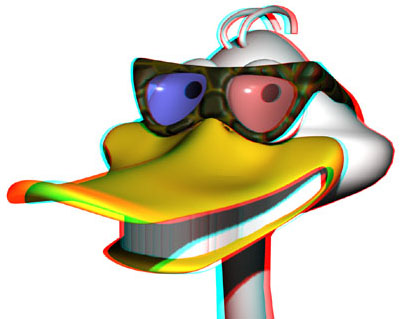
The perception of depth is based on the viewing of one image from two slightly different angles. This is the function of our two eyes as we look onto the real world. This binocular vision is the only real way that we perceive depth. Although, we can still see in 3D even when we cover one eye, the 3D information we get is contrived from cues which we are trained to or experienced in perceiving. Such cues, called monocular depth cues include relative size of the object, shadow of the object and interposition.
The function of an anaglyphic image is to simultaneously present two separate views of an object to the appropriate eyes. This is done by manipulating colors and filters.
An anaglyphic image involves two images, one red, and the other blue/green. The images are spaced slightly apart from each other, usually the distance between your two eyes. The greater this difference is, the more radically the picture protrudes or recedes - although if they are too far apart, the illusion is ruined.
The viewing device is a pair of red-green glasses. On the left eye is a piece of red cellophane, while on the right eye, there is blue/green cellophane. The left eye will see the blue image and filter our the red one. Conversely, the right eye will perceive the red image and filter out the blue image. As a result, each eye gets the information of the designated image.

Through the process of filtering, the eyes will appropriately perceive two separate images.
The brain is thus presented with two picture images, viewed at slightly different angles. This is what produces the 3D effect. The order of the red and blue parts of the image can be altered to create protruding and receding effects. This is illustrated in the following anaglyph.

In this picture, the protrusion effect of the ducks bill is created by spacing the red image a little to the left of the blue. However, this order is reversed in the image colors of the head - the red image is to the right of the blue image. As a result of this reversal, the head looks instead, like it is beyond the surface, or receding from the viewer. The manipulation of both protruding and receding effects make for very exciting anaglyphs.
|
| ||
BACK |
|
NEXT |